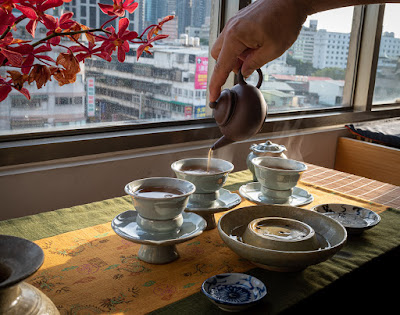 |
| 2003 wild Yiwu puerh |
But let's first acknowledge that tea is very conservative and traditional in the sense that it takes centuries to evolve. First, from the Han to the Tang dynasty, tea used to be boiled. Then came the 'whisked in a tea bowl' transition that lasted for 2 dynasties, Song and Yuan, or about 400 years. Eventually, the method of brewing loose leaves started during the Ming dynasty, around 1370. Brewing Chinese tea, especially green tea, hasn't changed much in the last 600 years.
Besides. porcelain had been mastered during the Eastern Han period (25-220 AD) and we can see that shapes and styles of tea accessories are passed from generation to generation and from one dynasty to another.
The most famous tea book and tea master in Chinese history is Lu Yu (733-804) who is to tea what Confucius is to Chinese philosophy: a distant voice from the past who understood how everything is connected before anybody else.
So, I think that there's a good case to be made that brewing Chinese loose leaf tea is a very traditional and conservative activity.
But, on the other hand, when you look at the Chaxi I'm posting in my articles, don't you think that each one is rather unique and not something repetitive that we associate with traditions? The Chaxi, my set up and my brewing are not rigidly codified. There's no fixed recipe like X grams of tea, Y ml of water at temperature Z brewed for T seconds. There are rules, but only few (preheating, boiling water) and there's lot of freedom within them. What counts is not the respect of ancient traditions per se, but the pursuit of tea happiness!
So, is a Chaxi more liberal and progressive than traditional?
Well, as I said earlier, tea is meant to bring us together and I now want to introduce the central idea of the Chaxi: harmony.
Harmony of colors, harmony of feeling, harmony between the tea and the accessories, harmony of the taste, of seasons... A Chaxi aims to combine and to create this harmony between everything. It uses what we've learned from the past, the beautiful shapes that were handed down from one generation to another... And the more the Chaxi links the past to the present, builds on traditions to express our individual creativity and feeling, the closer we come to beauty and harmony.
So, for me, the Chaxi is both conservative and progressive. It keeps the tea traditions alive and it stimulates my own creativity.
Harmony is to seek this balance.
Chaxi list:
Yixing Shuiping teapot
Tea boat by a Taiwanese friend
Yuan style celadon cups by David Louveau
Ancient celadon tea jar
Late Qing dynasty qinghua plates
Japanese silver teapot
Celadon Jianshui based on a Jin dynasty (266-420) jar
Celadon vase by Jacob Bodilly
Chabu created by tea-masters.com
2003 Spring wild raw puerh from Yiwu














2 comments:
Hi Stephane,
I appreciate the Chaxi list(s) at the bottom.
In 1993, I watched the movie A River Runs Through It. I had gone fishing from time to time, but I would drag a metal spoon through the water. In the span of 2 hours, I'd discovered that fishing could be an art form... it's poetry. After that movie, I learned to tie my own flies and spent hundreds of hours learning to read the water and perfecting my casts.
That's how I see Chaxi brewing... tea art. I grew up in Canada, plunking a tea bag into a mug. Then I discovered gong fu brewing, and eventually the elegant simplicity of striving for the perfect pot of tea, set on a harmonious and minimalist stage. I value the traditions, and taking the time to heat the coals in my Nilu. But there's a contemporary trend that is taking people back to tea practice, as a way of better handling our modern world. That's how I discovered Chaxi.
Cole
Hi Cole,
I remember this movie. It had excellent photography! Vivid colors and light.
Thanks for sharing how you started to enjoy tea!
Post a Comment